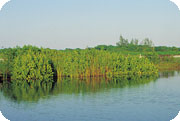Brac Facts
Conserving the Brac
Conservation concerns everybody - Taking care of our precious resources is a way of life on the Brac. Planned development has to date minimized human intrusion on wildlife habitats. Government attitudes are environmentally proactive, with protective legislation enacted and enforced since the 1970s and major new marine and terrestrial conservation laws are also presently being enacted.
Brac Parrot
 |
Looking after the land - Saltwater Pond is designated as a sanctuary under
the Animal's Law 2000. Established by the National Trust for the Cayman Islands in 1990, the 310-acre
Brac Parrot Reserve provides safe nesting for the endangered Cayman Brac parrot as well as all other
birds and the flora and fauna. The Reserve's two-mile nature trail unfolds among 38 species of trees.
Trust members offer information and displays at their National Trust House in White Bay. The Heritage
House and the National Trust Headquarters on the north coast provides
information on flora and fauna, trails and sites. The 6 to 8 miles of walking and hiking trails are
public rights of way and are a wonderful way to view the flora and fauna. The bluff forest is designated
as an Important Bird Area (IBA) because it supports two near-threatened species, Brac parrot and
vitelline warbler. A recent study of the brown booby colony has led to a recommendation to designate the
eastern and southern faces of the bluff as a national park to protect its rich biodiversity.
Saving our seas - The Cayman Islands have the most stringent marine conservation
laws of any Caribbean nation. Specific regulations control fishing methods, areas, seasons and catch
size as well as pollution. Key rules for visitors: no spearguns; no removal of any marine life while
using scuba gear; leave the sea turtles alone!
|
 |


|
 |




Brown Booby



Heritage House

Lighthouse

|





